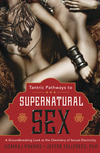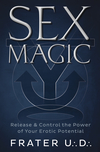Tantra and Women

Most classical Tantric texts seem to have been written primarily with men in mind. For example, the Gheranda Samhita, a 16th-century Tantric/Yogic text advises: "By virtue of this Yoga, the Bindu-Siddhi (retention of seed) is obtained, and when that Siddhi is obtained what else can he not attain in this world."1 Similarly much of the popular mythology about Tantric sex focuses on prolonged lovemaking and concomitant male staying-power (retention of seed), as if that were the defining feature of the Tantric experience. In Tantra: The Art of Conscious Loving, Charles and Caroline Muir contend that tantric practitioners believe that the age-related prolongation of the refractory period is a sign of "the second chakra's depletion" due to the "too-frequent expulsion of the life essence contained in the man's semen." 2 While we are aware of one contemporary neo-Tantric teacher who claims that female ejaculation causes cervical cancer, injunctions about control of the bindu, ojas or semen are almost always directed at men, as are virtually all the other instructions in the classical texts.
This emphasis on male practitioners may seem paradoxical and sexist—paradoxical because women are revered in Tantra, and Tantra is one of the rare spiritual traditions in which women have functioned for centuries as spiritual teachers and initiators, sexist because the almost entirely male focus of the texts might be construed as reflecting a belief that women are spiritually inferior. An examination of Tantra's history and a more nuanced understanding of the texts should resolve the apparent paradox and make it clear that the presumed male audience is evidence of sexism in Indian society in general but not in the Tantric tradition itself.
The earliest forms of Tantric sexual ritual involved the possession of female practitioners by ravenous deities. These deities would share their power with men and could be propitiated with an offering of semen. The admixture of male and female sexual fluids and the consumption thereof was the source of both initiation and gnosis. But the power always emanated from the woman.3 This tradition has not died out, and we describe a modern form of this ancient sexual ritual in detail in "The Tantric Mass and The Secret of Amrita," chapter 15 of The Essence of Tantric Sexuality.
Given this history and the importance of semen as an offering, it seems odd that some texts would emphasize retention. In part this is due to the influence of Ayurvedic and folk beliefs (which exist in many cultures) that semen is a vital fluid and that spilling or "wasting" it leads to depletion, but this is view is antithetical to the original Tantric approach. Moreover, there is a risk in taking the classical texts literally, and it seems plausible to suggest that the emphasis on male retention, to the extent that it exists in some but not all of the scriptures, has more to do with developing a more feminine pattern of sexual response than it does with wasting vital energy. Dr. Jonn Mumford (Swami Anandakapila Saraswati) has observed: "In Tantra the female has always been considered, when awakened, a natural repository of energy and realization, anchored in the heart, while men, with their outward forward floodlight gaze need the instruction about how to convert consciousness to dwell in the altar of the heart and lead the energy upward through training to focus consciousness as a spotlight." Implicit in Swami Anandakapila's observation is the idea that women, in general, are more readily awakened than men, an echo of the ancient Tantric belief that women are the initiators and holders of spiritual power. From this perspective, retention of semen is a learning tool and nothing more.
There is an additional, somewhat more mundane, reason for the emphasis on men that pervades the classical Tantric scriptures, including those that do not pertain to sexual ritual. Most of these texts were composed between the 6th and 17th Centuries, CE. In India, as in Europe, literacy was largely the province of men during this period. Except for aristocrats and courtesans, literacy was rare among women, so it stands to reason that the texts were composed for a male audience. Textual knowledge, however, has never been a central to Tantra, which emphasizes the oral tradition and the passage of knowledge and initiation from "mouth to ear." Female spiritual teachers have played an important role in both Hindu and Buddhist Tantra for well over a millennium, a fact that sets the Tantric tradition apart from most other spiritual paths. This further reinforces the notion that textual knowledge is not a prerequisite for spiritual accomplishment and provides concrete evidence that the textual focus on men is in large part an artifact of the broader culture, not a reflection of any judgment about women's spiritual capacities.
It is important to bear in mind that in the Tantric worldview, we all contain male and female aspects. Ardhanarishwara, a hermaphroditic form of Shiva, is the ruler of Ajna Chakra (the third eye). Thus, the key to inner wisdom lies in embracing our inner androgyny. Similarly, the Gheranda Samhita includes a meditation in which the male yogi visualizes himself as Shakti (the divine feminine) in sexual union with the male deity; through this practice, the yogi experiences himself as divine. This inner androgyny is something that everyone can profit from exploring, regardless of physical gender, and women can modify the textual instructions accordingly. The Tantric practitioners of old undoubtedly did so, whether they were male or female, literate or illiterate. While the Tantric texts were generally written for a masculine audience, Tantra was not, in any way, the exclusive province of men; the Tantric approach can work for anyone.
1. Rai Bahadur Srisa Chandra Vasu, trans. The Gheranda Samhita (Allahabad, 1914. Reprint, New York: AMS Press, 1975.), 27.
2. Charles and Caroline Muir, Tantra: The Art of Conscious Loving (San Francisco: Mercury House, 1989), 78-79.
3. See David Gordon White, Kiss of the Yogini: "Tantric Sex" in its South Asian Contexts, (Chicago: University of Chicago Press, 2003) for an in-depth discussion of this subject.

About Mark A. Michaels
Related Products



is subject to certain Terms and Conditions